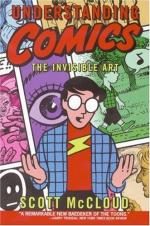
|
| Name: _________________________ | Period: ___________________ |
This test consists of 5 multiple choice questions, 5 short answer questions, and 10 short essay questions.
Multiple Choice Questions
1. What symbol does the author use to demonstrate the universality of cartoon imagery?
(a) American flag
(b) Stop sign
(c) Human face
(d) Peace sign
2. How long is the tapestry detailing the Norman Conquest of England?
(a) 12 yards
(b) 230 feet
(c) 100 feet
(d) 36 meters
3. What additional early examples of comics does the author mention but NOT cover?
(a) Trajan's column
(b) Japanese scrolls
(c) All of the above
(d) Greek painting
4. Japanese comics artists also drew more realistic characters to emphasize __________________________.
(a) their "otherness" from the reader
(b) the strokes
(c) the artist's range and skill
(d) the character's relatability
5. Which of the following is an assumption that comics artists make about the reader?
(a) They read the comics in one sitting.
(b) They will like the story.
(c) They have read previous stories in the series.
(d) They read the panels in correct order.
Short Answer Questions
1. What is a powerful force that happens between the panels that allows viewers to use their imagination?
2. Panel shapes affect which of the following?
3. Who was the first artist to present specific motions in a panel-to-panel form?
4. Which of the following is NOT a characteristic of comics, as defined in Understanding Comics?
5. Closure in comics fosters an intimacy between ________________________.
Short Essay Questions
1. Is a single image equivalent to a single instant in time?
2. In the panel with the basketball players, how could you add words while depicting one single moment?
3. For what do Japanese mainstream comics use aspect-to-aspect transitions?
4. What is a Japanese technique usied in cartooning?
5. According to McCloud, are comics a hybrid of graphic arts and prose fiction?
6. What is the difference between the art form ("medium") and the content?
7. What are the three most popular transitions in mainstream Western comics and why?
8. Give examples of the three different types of icons.
9. Does McCloud think single panels should be considered comic art?
10. How is the Egyptian painting referenced in the book considered a comic?
|
This section contains 764 words (approx. 3 pages at 300 words per page) |

|




